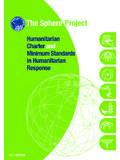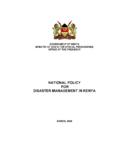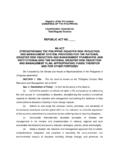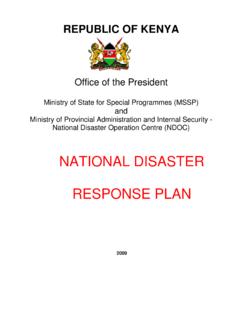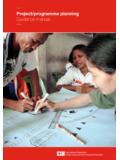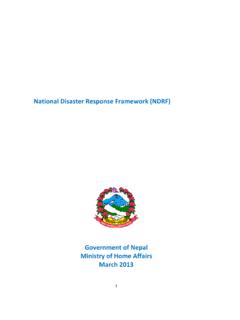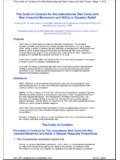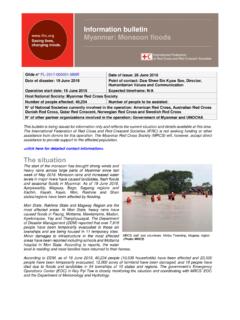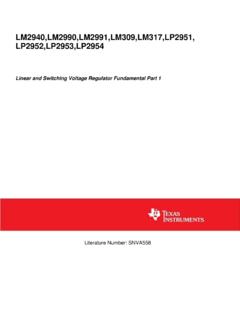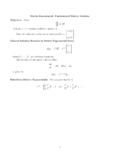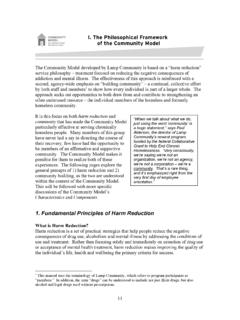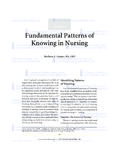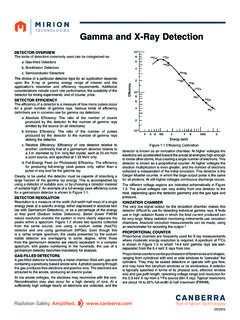Transcription of COMMENTARY By: Jean Pictet - IFRC.org
1 International Federation of Red Cross and Red Crescent Societies 1979 THE FUNDAMENTAL PRINCIPLES OF THE RED CROSS COMMENTARY BY: JEAN Pictet P a g e | 2 Contents Proclamation of the Fundamental Principles of the Red Cross .. 4 INTRODUCTION .. 5 A reminder .. 5 A universal doctrine .. 6 Definition and classification .. 8 Translating principles into action .. 9 Some additional observations .. 10 I. HUMANITY .. 12 Preamble .. 12 Terminology .. 13 COMMENTARY .. 14 (a) To prevent and alleviate suffering .. 14 (b) To protect life and health .. 16 (c) To assure respect for the individual .. 17 The Red Cross and peace .. 18 Philosophical considerations .. 21 II. IMPARTIALITY .. 24 .. 24 COMMENTARY .. 24 Philosophical considerations .. 26 .. 27 COMMENTARY .. 27 Red Cross practice .. 28 Philosophical considerations .. 30 .. 31 COMMENTARY .. 31 III. NEUTRALITY .. 34 General Observations.
2 34 COMMENTARY .. 35 (a) Confidence .. 35 (b) Military neutrality .. 35 (c) Ideological neutrality .. 36 Other aspects of neutrality .. 38 IV. INDEPENDENCE .. 40 P a g e | 3 The General Principles of Independence .. 40 2. Auxiliary Status .. 41 3. Independence from public authorities .. 43 V. VOLUNTARY SERVICE .. 46 Terminology .. 46 Service .. 46 Service .. 49 .. 51 Spirit of Service .. 52 VI. UNITY .. 54 .. 54 2. Multitudinism .. 54 3. Generality of Action .. 56 VII. UNIVERSALITY .. 57 1. Universality .. 57 2. The Equality of National Societies .. 58 3. Solidarity .. 59 P a g e | 4 Proclamation of the Fundamental Principles of the Red Cross The XXth International Conference of the Red Cross proclaims the following fundamental principles on which Red Cross action is based: HUMANITY The Red Cross, born of a desire to bring assistance without discrimination to the wounded on the battlefield, endeavours in its international and national capacity to prevent and alleviate human suffering wherever it may be found.
3 Its purpose is to protect life and health and to ensure respect for the human being. It promotes mutual understanding, friendship, co-operation and lasting peace amongst all peoples. IMPARTIALITY It makes no discrimination as to nationality, race, religious beliefs, class or political opinions. It endeavours only to relieve suffering, giving priority to the most urgent cases of distress. NEUTRALITY In order to continue to enjoy the confidence of all, the Red Cross may not take sides in hostilities or engage at any time in controversies of a political, racial, religious or ideological nature. INDEPENDENCE The Red Cross is independent. The National Societies, while auxiliaries in the humanitarian services of t heir Governments and subject to the laws of their respective countries, must always maintain their autonomy so that they may be able at all times to act in accordance with Red Cross principles.
4 VOLUNTARY SERVICE The Red Cross is a voluntary relief organization not prompted in any manner by desire for gain. UNITY There can be only one Red Cross Society in any one country. It must be open to all. It must carry on its humanitarian work throughout its territory. UNIVERSALITY The Red Cross is a world-wide institution in which all Societies have equal status and share equal responsibilities and duties in helping each other. P a g e | 5 INTRODUCTION To think without acting leads to nothing, but to act without thinking leads to disaster. -Japanese proverb. A reminder The Twentieth International Red Cross Conference, meeting in Vienna in 1965, proclaimed the fundamental principles upon which Red Cross action is based . Since that time, at every Conference, the representatives of the Red Cross world rise to their feet to hear the solemn reading of those principles.
5 The principles, however, have not yet been the subject of any COMMENTARY . The fact is that the book Les principes de la Croix-Rouge, the source of the Vienna text, antedated the official version which, while being close to the model, was not identical with it. The book referred to was indeed a complete work, of a somewhat scientific character, and not a terse COMMENTARY designed to serve the general public. A desire has therefore been expressed particularly in relation to the study on the Re-appraisal of the Role of the Red Cross, for a simple and modern COMMENTARY which would make these principles understandable to everyone, and especially to the young people, who represent the future. For these reasons, the International Committee of the Red Cross, the League of Red Cross Societies and the Swiss Red Cross have asked the Henry Dunant Institute to prepare such a COMMENTARY .
6 This book is intended to meet that request. For obvious reasons, it contains elements from Red Cross Principles , in abbreviated form, supplemented by more recent material. The author of the Final Report on the Re-appraisal of the Role of the Red Cross raised questions as to precisely what constituted Red Cross principles, commenting that there was some confusion concerning them. In reality, there is no possible doubt, at least with regard to the fundamental principles, for these are set forth in the Proclamation of 1965, whose fundamental character is obvious. The Red Cross world was determined at that time to provide itself with a true charter, as the fruit of a century of experience and the lasting basis for its future activity. There is also another text on the principles of the Red Cross, adopted by the Board of Governors of the League at Oxford in 1956 and approved by the Eighteenth International Red Cross Conference in 1952.
7 However, the joint commission responsible for drafting the fundamental principles, which subsequently became the Proclamation of 1965, took the Oxford text into consideration and took from it material of a general character. The Oxford text, a verbose and loosely drafted document produced at the end of the Second World War, consists for t he most part of organic or institutional principles and of simple rules for action which continue to be valid within these limits but which have no place in a proclamation. The same is true for various precepts set forth in resolutions by the International Red Cross Conferences. P a g e | 6 It will certainly be useful in due course to bring together all those organic principles, now so dispersed, into a single declaration to which the International Conference could give its approval. Furthermore, we must avoid confusion of the principles of the Red Cross with the principles of international humanitarian law, mainly embodied in the Geneva Conventions for the protection of the victims of war.
8 The former serve at all times to inspire the action of the Red Cross as a private institution, whereas the latter, which have an official character, regulate in wartime the conduct of States vis- -vis their enemies. There is nevertheless a link between these two fields, for humanitarian law had its origin in the ideal of the Red Cross, which continues to stimulate its development. Thus there are certain principles, such as those of humanity and of non-discrimination, which in a sense are common to both. In addition, when they accord their protection to the National Societies of the Red Cross, the Conventions refer on occasion to activities which are in conformity with the principles laid down by the International Red Cross Conferences. These principles are indeed none other than those embodied in the Vienna Proclamation. The present work will therefore be concerned with providing a COMMENTARY on that Proclamation.
9 In presenting the Proclamation to the International Red Cross Conference in 1965, its authors by no means believed that they had achieved perfection at the first attempt. The fact is that the text suffers from some defects and omissions which will become apparent in the light of the critical examination to which we shall subject it in this study. This should help us sketch the outlines of a future revision when the time comes, for nothing in this world is unchangeable. These imperfections do not, however, have such importance or urgency as to require an early revision. As it stands today, the Proclamation provides the Red Cross, now and for a long time to come, with a firm and healthy doctrinal foundation. A universal doctrine The work of the Red Cross is born of a high ideal, from which it continually draws fresh life, but as it primarily consists of practical actions, frequently improvised, there is a serious risk that in the haste of charitable action and in spite of the purity of one s intentions, one may deviate from the guiding principles, and unity of thought may be lacking.
10 There is also the fact that the Red Cross takes root in all parts of the world, differing greatly one from another. The National Societies are extremely varied, and each has its own distinctive character. Some are strong while others are still weak: they may have many members or only a few: some have had long experience while others have just come into existence. They do not all have identical activities and some do not have clearly defined programmes. The doctrine of the Red Cross therefore along with, but more important than, the Statutes of the International Red Cross is the real link between these Societies, the cement which holds the stones together to make of them a solid and well built edifice. It is this doctrine which creates the unity and the universality of the structure, which, indeed, makes the Red Cross a reality.
